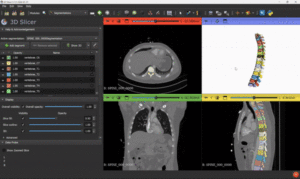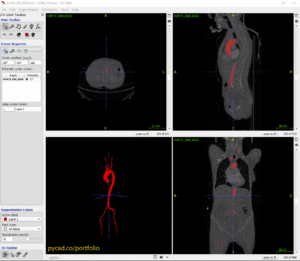Split Your Large Volume into Small Chunks
Introduction
Dealing with large medical datasets can be challenging. Training a model with these large volumes in their entirety is often not feasible for two main reasons:
- Inconsistent Number of Slices: Medical images often have varying numbers of slices, making it difficult to standardize the data for training.
- Computational Limits: Running convolutions on large arrays (e.g., volumes with 500 slices) can be computationally prohibitive.
To address these challenges, splitting the volumes into smaller, more manageable chunks is a practical approach. Using specialized libraries like SimpleITK ensures that we maintain the correct orientation, spacing, and origin for each chunk. This post will guide you through the process of efficiently handling large NIfTI datasets by splitting them into chunks, visualizing the chunks, and understanding the metadata.
Step-by-Step Guide to Splitting Large NIfTI Volumes
Import Required Libraries
First, we need to import the necessary libraries:
import SimpleITK as sitk
import os
import matplotlib.pyplot as plt- SimpleITK: For image processing.
- os: To interact with the operating system (e.g., creating directories).
- matplotlib.pyplot: For visualizing the image chunks.
Function to Load and Process Image in Chunks
The following function loads a large NIfTI image and processes it in chunks:
def load_and_process_image_in_chunks(filepath, chunk_size, output_dir):
# Ensure the output directory exists
os.makedirs(output_dir, exist_ok=True)
# Load the image
image = sitk.ReadImage(filepath)
size = image.GetSize()
print("Image Direction: ", image.GetDirection())
print("Image Spacing: ", image.GetSpacing())
print("Image Origin: ", image.GetOrigin())
for z in range(0, size[2], chunk_size):
region_size = [size[0], size[1], min(chunk_size, size[2] - z)]
region_index = [0, 0, z]
region = sitk.RegionOfInterest(image, region_size, region_index)
print("Region Direction: ", region.GetDirection())
print("Region Spacing: ", region.GetSpacing())
print("Region Origin: ", region.GetOrigin())
# Save the chunk
chunk_filename = os.path.join(output_dir, f"chunk_{z}.nii")
sitk.WriteImage(region, chunk_filename)
# Yield the chunk for further processing if needed
yield region, chunk_filenameExplanation:
Load the Image:
image = sitk.ReadImage(filepath)reads the NIfTI image.
Get Image Size:
size = image.GetSize()retrieves the dimensions of the image.
Process the Image in Chunks:
- The loop iterates over the z-axis in steps of
chunk_size. region_sizeandregion_indexdefine the size and starting point of each chunk.region = sitk.RegionOfInterest(image, region_size, region_index)extracts the chunk.
Save Each Chunk:
- The chunk is saved using
sitk.WriteImage(region, chunk_filename).
Yield the Chunk:
- The function yields each chunk and its filename for further processing.
Function to Visualize Saved Chunks
The following function visualizes the saved chunks:
def visualize_image(filepath):
image = sitk.ReadImage(filepath)
image_array = sitk.GetArrayViewFromImage(image)
# Display the image slice by slice
num_slices = image_array.shape[0]
for i in range(num_slices):
plt.imshow(image_array[i, :, :], cmap='gray')
plt.title(f'Slice {i+1}/{num_slices}')
plt.axis('off')
plt.show()Complete Usage
Here’s how you can use the functions to process and visualize a large NIfTI image:
# Load and process image in chunks
filepath = "path_to_large_image.nii"
chunk_size = 50
output_dir = "output_chunks"
for chunk, chunk_filename in load_and_process_image_in_chunks(filepath, chunk_size, output_dir):
print(f"Saved chunk: {chunk_filename}")
# Visualize saved chunk
chunk_filepath = "output_chunks/chunk_0.nii"
visualize_image(chunk_filepath)Replace path_to_large_image.nii and output_chunks with the actual paths in your environment. This example processes a large NIfTI image in chunks, saves each chunk, and provides a function to visualize the saved chunks.
Understanding Metadata and Origins
In medical imaging, metadata such as direction, spacing, and origin are crucial for correctly interpreting the images. When splitting the image into chunks, each chunk retains the original image’s metadata, ensuring consistency and accuracy in further analysis and processing.
- Direction: Indicates the orientation of the image axes relative to the physical world.
- Spacing: The physical distance between the centers of adjacent pixels along each axis, usually in millimeters.
- Origin: The physical coordinates of the first voxel of the image.
Conclusion
By splitting large medical images into smaller chunks, you can handle them more efficiently for training machine learning models. Using SimpleITK ensures that each chunk maintains the correct orientation, spacing, and origin, which is critical for accurate analysis.
At PYCAD, we specialize in providing advanced solutions for medical imaging. Our expertise in image processing and machine learning enables us to handle large datasets efficiently, delivering high-quality results for medical research and clinical applications.
- YouTube Channel: PYCAD on YouTube
- Newsletter: Join Our Newsletter
- GitHub: Our GitHub Profile
- Portfolio: Our Portfolio



